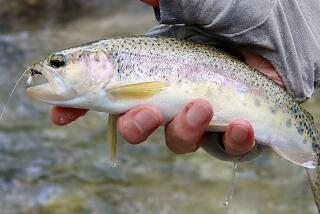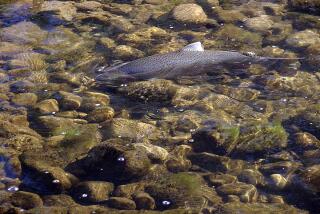Luring Casts of Thousands : Anglers Reel at the Environmental Impact as Fly-Fishing Appeals to Growing Numbers
- Share via
Standing knee-deep in Piru Creek near Pyramid Lake, Bill Liebegott bends forward to study the swirling currents and eddies 10 feet upstream. Liebegott scans the surface of the shallow creek for insects, nymphs--any aquatic life that would attract a hungry rainbow trout.
Suddenly, Liebegott rears back, flicking his line like a bullwhip and casting his blue-green fly squarely into the center of the creek. The fly floats on the surface as Liebegott pulls the line back downstream.
Liebegott is using a dry fly because he expects the fish to look up to the water’s surface for their food. Since 90% of rainbow trout feed underwater, Liebegott knows that he’s bucking the odds with that strategy.
But the method only helps enhance Liebegott’s satisfaction when he snags an elusive trout.
“Fly-fishing is not easy,” he says. “So when you are able to conquer the difficulty and catch a fish, there’s an extra reward.”
Liebegott, 46, of Newbury Park, is vice president of the Conejo Valley Flyfishers, one of several fly-fishing clubs in Southern California. Other area clubs include the Valley-based Sierra Pacific Flyfishers and the Sespe Flyfishers in Ventura.
Since Rod Tochihara founded the Conejo Valley Flyfishers three years ago, the organization has grown to include more than 50 members. The sport of fly-fishing has also experienced burgeoning growth throughout the last decade, as have most other forms of fishing.
Indicative of this growth, there are now an estimated 60 million anglers in the United States--one out of every four people--who annually spend more than $30 billion on fishing.
And while the best fly-fishing might be found in the alpine lakes or creeks of Montana and Wyoming, Southern California also has its share of popular areas. Accessible spots from the Valley area include: Piru Creek near Pyramid Lake, located one hour north of the San Fernando Valley; Sespe Creek in Ojai; Deep Creek in Lake Arrowhead; the west bank of the San Gabriel River in Azusa; and Malibu Creek in the Santa Monica Mountains.
“There are a lot of places nearby where the scenery is so nice that you don’t feel like you’re living in Southern California,” Liebegott said. “It’s like you’re living in Montana.”
Indeed, the booming popularity of fly-fishing alarms many of the sport’s ardent enthusiasts.
“The fishing pressure is just so heavy that unless you regulate some of these waters, the fish are not going to be able to keep up with the number of fishermen,” Liebegott said.
Fly-fishing surged in popularity under former President Jimmy Carter, who stored numerous rainbow-hued flies and assorted fly-tying paraphernalia in a room adjacent to his White House bedroom.
In Carter’s new book, “An Outdoor Journal,” he espouses the joys of fly-fishing for trout. Several chapters are devoted to the rudiments of fly-tying, the feeding habits of fish and the importance of the catch-and-release system.
A layman might not understand why a fly-fisherman, who goes to the trouble of catching an elusive wild trout, would then release it. But for experienced fly-fishermen like Liebegott, releasing the fish is necessary to preserve the environment.
“There’s a tremendous feeling of satisfaction when you’ve enjoyed the beauty, met the challenge and caught the trout, but you didn’t kill anything,” said Liebegott, who often uses a barbless hook to minimize harm to the fish. “To be a good fly-fisherman you have to understand the trout’s environment, and when you understand the trout’s environment, you realize just how fragile it is.”
Clubs like the Conejo Valley Flyfishers stage conservation projects to protect the habitat at the various streams and creeks in Southern California. For example, members from several fly-fishing clubs planted the willow trees lining the banks at Piru Creek.
In addition, conservation is discussed at the monthly meeting of the Conejo Valley Flyfishers, along with such subjects as safety, hypothermia, knot-tying and fly-tying.
For true aficionados of fly-fishing, tying flies is a special art form. The special-interest craft has a cultural center, the American Museum of Fly-Fishing, located in Manchester, Vt. Fishermen like Liebegott spend countless hours twisting, gluing and mounting the tiny, colorful flies that adorn their hooks, striving for just the right shape and appearance.
Fly-tiers make use of bits of feathers, fur or any material that might attract a fish and divert its attention from the hook.
“Fly-tying is a sport or hobby unto itself,” Liebegott said. “Although it marries itself beautifully with fly-fishing, it’s more like a separate art.
“It’s like oil painting. There are some creations that are just exquisite.”
A colorful fly is of little use in practice, however, unless the fisherman is equally adept at casting and presenting the fly.
“If you don’t have a drag-free float, the fish is not going to hit no matter how realistic looking the fly,” said Liebegott, who takes special pride in his nymph flies.
Liebegott, who learned fly-fishing as a youth on the banks of a river near his New York home, is known to spend hours casting without ever attracting having a nibble. The lulls give him time to enjoy another facet of his favorite sport.
“When I’m in an area that has a lot of natural beauty and I feel like I’m the only one there, I can fish all day and not even care if I catch anything,” Liebegott said.
More to Read
Sign up for The Wild
We’ll help you find the best places to hike, bike and run, as well as the perfect silent spots for meditation and yoga.
You may occasionally receive promotional content from the Los Angeles Times.





